Different Types of Chassis (Cont'l)
Glass-Fiber body
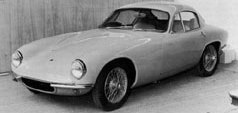 To
many sports cars specialists, glass-fiber is a perfect material. It
is lighter than steel and aluminium, easy to be shaped and rust-proof.
Moreover, the most important is that it is cheap to be produced in
small
quantity - it needs only simple tooling and a pair of hands. There are
a few drawbacks, though: 1) Higher tolerence in dimensions leads to
bigger
assembly gaps can be seen. This is usually percieved as lower visual
quality
compare with steel monocoque. 2) Image problem. Many people don't like
"plastic cars".
To
many sports cars specialists, glass-fiber is a perfect material. It
is lighter than steel and aluminium, easy to be shaped and rust-proof.
Moreover, the most important is that it is cheap to be produced in
small
quantity - it needs only simple tooling and a pair of hands. There are
a few drawbacks, though: 1) Higher tolerence in dimensions leads to
bigger
assembly gaps can be seen. This is usually percieved as lower visual
quality
compare with steel monocoque. 2) Image problem. Many people don't like
"plastic cars".
Glass-fiber has
become a
must for British sports car specialists because it is the only way to
make
small quantity of cars economically. In 1957, Lotus pioneered
Glass-Fiber
Monocoque chassis in Elite (see picture). The whole mechanical stressed
structure was made of glass-fiber, which had the advantage of
lightweight
and rigidity like today's carbon-fiber monocoque. Engine, transmission
and suspensions were bolted onto the glass-fiber body. As a result, the
whole car weighed as light as 660 kg.
However, this radical
attempt
caused too many problems to Colin Chapman. Since the connecting points
between the glass-fiber body and suspensions / engine required very
small
tolerances, which was difficult for glass-fiber, Lotus actually
scrapped
many out-of-specification body. Others had to be corrected with
intensive
care. As a result, every Elite was built in loss. Since then, no any
other
car tried this idea again.
Today, no matter
Lotus, TVR,
Marcos, GM's Corvette / Camaro / Firebird, Venturi and more, employ
glass-fiber
in non-stressed upper body. In other words, they just act as a
beautiful
enclosure and provide aerodynamic efficiency. The stressed chassises
are
usually backbone, tubular space-frame, aluminium space-frame or even
monocoque.
| Advantage: |
Lightweight.
Cheap to be produced in small quantity. Rust-proof. |
| Disadvantage: |
Lower visual
quality. Unable
to act as stressed member. |
| Who use it ? |
Lotus, TVR,
Marcos, Corvette,
Camaro, Firebird ... |
Carbon-Fiber Monocoque
Carbon Fiber is the most
sophisticated
material using in aircrafts, spaceships and racing cars because of its
superior rigidity-to-weight ratio. In the early 80s, FIA established
Group
B racing category, which allowed the use of virtually any technology
available
as long as a minimum of 200 road cars are made. As a result, road cars
featuring Carbon-Fiber body panels started to appear, such as Ferrari
288GTO
and Porsche 959.
There are several
Carbon-fibers
commonly used in motor industry. Kevlar, which was developed by Du
Pont,
offers the highest rigidity-to-weight ratio among them. Because of
this,
US army's helmets are made of Kevlar. Kevlar can also be found in the
body
panels of many exotic cars, although most of them simultaneously use
other
kinds of carbon-fiber in even larger amount.
Production process
Carbon-fiber panels are
made
by growing carbon-fiber sheets (something look like textile) in either
side of an aluminium foil. The foil, which defines the shape of the
panel,
is sticked with several layers of carbon fiber sheets impregnated with
resin, then cooked in a big oven for 3 hours at 120°C and 90 psi
pressure.
After that, the carbon fiber layers will be melted and form a
uniformal,
rigid body panel.
Carbon-Fiber Panels VS Carbon-Fiber Monocoque
Chassis
 |
Porsche 959,
employed carbon-fiber
in body panels only, is obviously .... |
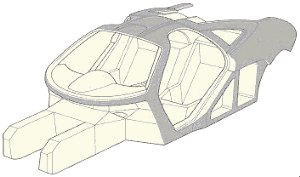 |
.... inferior
to McLaren
F1's carbon-fiber monocoque. This structure not only supports the
engine
/ drivetrain and suspensions, it also serves as a very rigid survival
cell. |
Exotic car makers like
to tell
you their cars employ carbon-fiber in construction. This sounds very
advanced,
but you must ask one more question - where is the carbon-fiber used ?
Body
panels or Chassis ?
Most so-called
"supercars"
use carbon-fiber in body panels only, such as Porsche 959, Ferrari
288GTO,
Ferrari F40 and even lately, the Porsche 911 GT1. Since body panels do
nothing to provide mechanical strength, the use of carbon fiber over
aluminium
can barely save weight. The stress member remains to be the chassis,
which
is usually in heavier and weaker steel tubular frame.
What really
sophisticated
is carbon-fiber monocoque chassis, which had only ever appeared in
McLaren
F1, Bugatti EB110SS (not EB110GT) and Ferrari F50. It provides superior
rigidity yet optimise weight. No other chassis could be better.
Carbon Fiber
Monocoque made
its debut in 1981 with McLaren's MP4/1 Formula One racing car, designed
by John Barnard. No wonder McLaren F1 is the first road car to feature
it.
| Car |
Body
|
Chassis |
| Ferrari 288GTO
(1985) |
carbon fiber
panels |
steel tubular
space frame |
| Porsche 959
(1987) |
carbon fiber
panels |
steel monocoque |
| Ferrari F40
(1988) |
carbon fiber
panels + doors |
steel tubular
space frame |
| McLaren F1 (1993) |
carbon fiber
panels |
carbon fiber
monocoque |
| Ferrari F50
(1996) |
carbon fiber
panels + doors |
carbon fiber
monocoque |
| Lamborghini
Diablo SV (1998) |
mostly
aluminium
panels, with carbon fiber bonnet + engine lid |
steel
tubular
space frame |
| Lamborghini
Diablo GT (1999) |
mostly carbon
fiber panels
+ aluminium doors |
steel tubular
space frame |
Engine act as stressed member - Ferrari F50
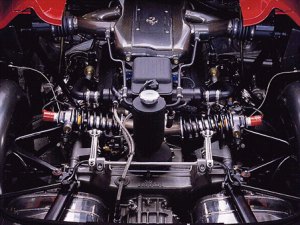 |
Unlike McLaren
F1, Ferrari
F50's rear suspensions are directly bonded to the engine / gearbox
assembly.
This means the engine becomes the stressed member which supports the
load
from rear axle. Then, the whole engine / gearbox / rear suspensions
structure
is bonded into the carbon fiber chassis through light alloy. This is a
first for a road car.
Advantage:
lighter still.
Disadvantage:
engine's vibration
directly transfers to the body and cockpit.
|
In 1963, a revolutionary
chassis
structure appeared in Formula One, that is, the championship-winning
Lotus
25. Once again, that was innovated by Colin Chapman. Chapman used the
engine
/ gearbox as mounting points for rear suspensions in order to reduce
the
width of his car as well as to reduce weight. In particular, reduced
width
led to lower aerodynamic drag. Of course, the engine / chassis must be
made stiffer to cope with the additional stressed from rear axle.
Today,
F1 cars still use this basic structure.
Characteristics
of carbon-fiber
monocoque:
| Advantage: |
The
lightest
and stiffest chassis. |
| Disadvantage: |
By far the
most expensive. |
| Who use it ? |
McLaren F1,
Bugatti EB110SS,
Ferrari F50. |
Aluminium Space Frame
Audi ASF
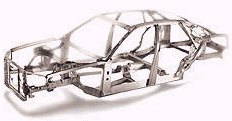 Audi
A8 is the first mass production car featuring Aluminium Space Frame
chassis.
Developed in conjunction with US aluminium maker Alcoa, ASF is intended
to replace conventional steel monocoque mainly for the benefit of
lightness.
Audi claimed A8's ASF is 40% lighter yet 40% stiffer than contemporary
steel monocoque. This enable the 4WD-equipped A8 to be lighter than BMW
740i.
Audi
A8 is the first mass production car featuring Aluminium Space Frame
chassis.
Developed in conjunction with US aluminium maker Alcoa, ASF is intended
to replace conventional steel monocoque mainly for the benefit of
lightness.
Audi claimed A8's ASF is 40% lighter yet 40% stiffer than contemporary
steel monocoque. This enable the 4WD-equipped A8 to be lighter than BMW
740i.
ASF consists of
extruded
aluminum sections, vacuum die cast components and aluminum sheets of
different
thicknesses. They all are made of high-strength aluminium alloy. At the
highly stressed corners and joints, extruded sections are connected by
complex aluminum die casting (nodes). Besides, new fastening methods
were
developed to join the body parts together. It's quite complex and
production
cost is far higher than steel monocoque.
The Audi A2 employed
the
second generation of ASF technology, which involves larger but fewer
frames,
hence fewer nodes and requires fewer welding. Laser welding is also
extensively
used in the bonding. All these helped reducing the production cost to
the
extent that the cheap A2 can afford it.
| Advantage: |
Lighter
than
steel monocoque. As space efficient as it. |
| Disadvantage: |
Still
expensive for mass
production |
| Who use it ? |
Audi |
Lotus Elise
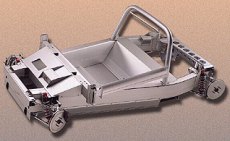 |
Elise's
revolutionary chassis
is made of extruded aluminium sections joined by glue and rivets. New
technology
can make the extruded parts curvy, as seen in the side members. This
allow
large part to be made in single piece, thus save bonding and weight. |
To Lotus and other
low-volume
sports car makers, Audi's ASF technology is actually infeasible because
it requires big pressing machines. But there is an alternative:
extruding.
Extrusion dies are very cheap, yet they can make extruded aluminium in
any thickness. The question is: how to bond the extruded parts together
to form a rigid chassis ?
Renault Sport Spider
bonds
them by spot welding, while Lotus Elise uses glue and rivet to do so.
Comparing
their specification and you will know how superior the Elise is:
|
|
Renault
Sport Spider
|
Lotus
Elise
|
|
Weight of
chassis
|
80 kg
|
65 kg
|
|
Torsional
stiffness
|
10,000
Nm/degree
|
11,000
Nm/degree
|
|
Thickness of
extrusion
|
3 mm
|
1.5 mm
|
Lotus's technology was
originated
by its supplier, Hydro Aluminium of Denmark. Hydro discovered that
aluminium
extrusion can be bonded by epoxy resin (glue) if it is adequately
prepared
by a special chemical in the bonding surface. Surprisingly, glue can
bond
the sections together strongly and reliably. Most important, the
aluminium
extruded sections can be made much thinner than traditional welding
technique.
Why ? because welded joints are weak, so the thickness of material
should
be increased throughout a member just to make a joint strong enough.
Therefore
Elise's chassis could be lighter yet stiffer.
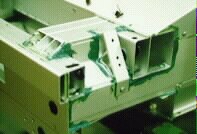 |
Glue can be
clearly seen
during production. |
Unquestionably, Lotus
Elise's
aluminium chassis is a revolution. I expect to see more British
specialty
cars to go this way.
| Advantage: |
Cheap
for low-volume
production. Offers the highest rigidity-to-weight ratio besides carbon
fiber monocoque. |
| Disadvantage: |
Not very space
efficient;
High door sill. |
| Who use it ? |
Lotus Elise,
forthcoming
Lotus M250, Opel Speedster |
Copyright©
1998-2000 by Mark Wan
AutoZine
Technical School
Return
to AutoZine home page
 To
many sports cars specialists, glass-fiber is a perfect material. It
is lighter than steel and aluminium, easy to be shaped and rust-proof.
Moreover, the most important is that it is cheap to be produced in
small
quantity - it needs only simple tooling and a pair of hands. There are
a few drawbacks, though: 1) Higher tolerence in dimensions leads to
bigger
assembly gaps can be seen. This is usually percieved as lower visual
quality
compare with steel monocoque. 2) Image problem. Many people don't like
"plastic cars".
To
many sports cars specialists, glass-fiber is a perfect material. It
is lighter than steel and aluminium, easy to be shaped and rust-proof.
Moreover, the most important is that it is cheap to be produced in
small
quantity - it needs only simple tooling and a pair of hands. There are
a few drawbacks, though: 1) Higher tolerence in dimensions leads to
bigger
assembly gaps can be seen. This is usually percieved as lower visual
quality
compare with steel monocoque. 2) Image problem. Many people don't like
"plastic cars".



 Audi
A8 is the first mass production car featuring Aluminium Space Frame
chassis.
Developed in conjunction with US aluminium maker Alcoa, ASF is intended
to replace conventional steel monocoque mainly for the benefit of
lightness.
Audi claimed A8's ASF is 40% lighter yet 40% stiffer than contemporary
steel monocoque. This enable the 4WD-equipped A8 to be lighter than BMW
740i.
Audi
A8 is the first mass production car featuring Aluminium Space Frame
chassis.
Developed in conjunction with US aluminium maker Alcoa, ASF is intended
to replace conventional steel monocoque mainly for the benefit of
lightness.
Audi claimed A8's ASF is 40% lighter yet 40% stiffer than contemporary
steel monocoque. This enable the 4WD-equipped A8 to be lighter than BMW
740i.

